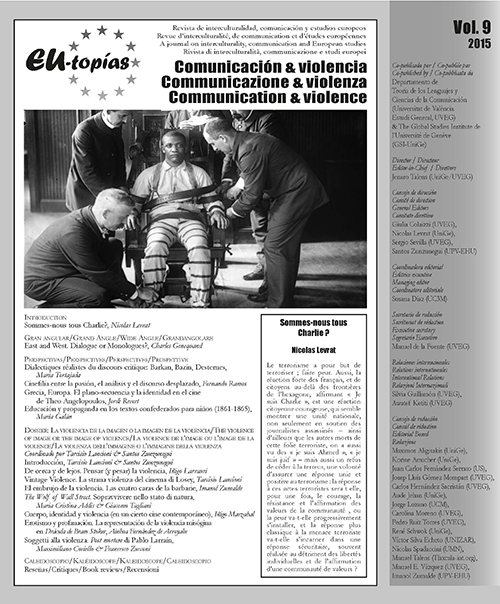Soggetti alla violenza. Post mortem di Pablo Larraín
DOI:
https://doi.org/10.7203/eutopias.0.18755Keywords:
Cinema, trauma, violence, dictatorship, testimony, Chile Abstract
Abstract
The possibility to build a subject who, exposed to violence, adjusts himself to respect the dictatorial regime is the paper’s key to the interpretation of Post Mortem (2010), the second part of Chilean director Pablo Larraín’s trilogy, dedicated to the story of the dictatorial regime in his country. The events occurred in 1973, the year of the coup d’état carried out by General Augusto Pinochet. The protagonist of the story is Mario, a civil servant in charge of transcribing and typing autopsy reports. By witnessing the daily exercise of violence, Mario fully internalizes the practice of violence since he does nothing but simply recording what happens. Following the civil servant in the performance of his routine, the paper analyzes the strategies with which the movie provides the spectator with the dictatorial regime’s main forms of subjection.
 Downloads
Downloads
 References
References
Arendt, Hannah (2001), Vita activa. La condizione umana, Milano: Bompiani, 2001.
Caruth, Cathy (1996), Unclaimed Experience. Trauma, Narrative, and History, Baltimore: The Johns Hopkins University Press.
Coviello, Massimiliano (2010), «Spettatori della dittatura: Tony Manero di Pablo Larraín», Fata Morgana. Quadrimestrale di cinema e visioni, 12, pp. 181-184.
Demaria, Cristina (2006), Semiotica e memoria. Analisi del post-conflitto, Roma: Carocci.
— (2012), Il trauma, l’archivio, il testimone, Bologna: Bononia University Press.
Dinoi, Marco (2008), Lo sguardo e l’evento. I media, la memoria, il cinema, Firenze: Le Lettere.
Fontanille, Jacques (2001), «L’osservatore come soggetto enunciativo», Paolo Fabbri e Gianfranco Marrone (ed.), Semiotica in nuce. Volume II. Teoria del discorso, Roma: Meltemi, pp. 44-63.
Freud, Sigmund (1976), «Lutto e melancolia», Opere VIII, 1915-1917. Introduzione alla psicoanalisi e altri scritti, Torino: Boringhieri.
— (1977), «Ricordare, ripetere e rielaborare», Opere VII, 1912-1914. Totem e tabù e altri scritti, Torino: Boringhieri.
Greimas, Algirdas J. (2001), «Semiotica figurativa e semiotica plastica», Paolo Fabbri e Gianfranco Marrone (ed.), Semiotica in nuce. Volume II. Teoria del discorso, Roma: Meltemi, pp. 196-210.
Hirsch, Marianne (2012), The Generation of Postmemory. Visual Culture after the Holocaust, New York: Columbia University Press.
LaCapra, Dominick (2001), Writing History, Writing Trauma, Baltimore: The Johns Hopkins University Press.
Lotman, Juri M. (1985), La semiosfera, Venezia: Marsilio.
Millán, Francisco Javier (2001), La memoria agitada: cine y represión en Chile y Argentina, Madrid: Ocho y medio.
Montani, Pietro (2011), L’immaginazione intermediale. Perlustrare, rifigurare, testimoniare il mondo visibile, Roma/ Bari: Laterza.
Spiller, Roland (ed.) (2005), Memoria, duelo y narración. Chile después de Pinochet: literatura, cine, sociedad, Madrid: Iberoamericana/Vervuert.
Villarroel, Mónica (coord.) (2014), Enfoques al cine chileno en dos siglos, Santiago de Chile: Lom Ediciones.
Violi, Patrizia (2014), Paesaggi della memoria. Il trauma, lo spazio, la storia, Milano: Bompiani.
Zucconi, Francesco (2013), La sopravvivenza delle immagini nel cinema. Archivio, montaggio, intermedialità, Milano: Mimesis.
Downloads
Published
How to Cite
-
Abstract129
-
PDF 67
Issue
Section
License
![]()
The authors conserve the copyright. All content published in EU-topías. Journal of interculturality, Communication, and European Studies are subject to the license Creative Commons Attribution-NonCommercial-ShareAlike 4.0 license. The full text of the license can be found at <http://creativecommons.org/licenses/by-nc-sa/4.0>
They may be copied, used, disseminated, transmitted and publicly displayed, provided that:
- The authorship and original source of the publication is cited (journal, publisher and URL of the work).
- They are not used for commercial purposes.
- The existence and specifications of this license of use are mentioned.
It is the responsibility of the authors to obtain the necessary permissions for images that are subject to copyright.



